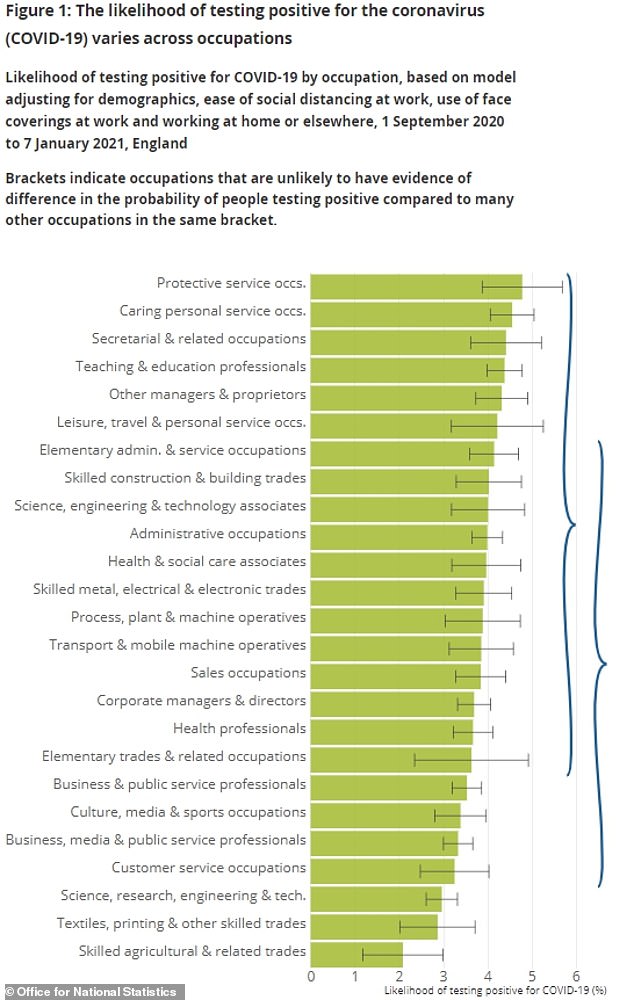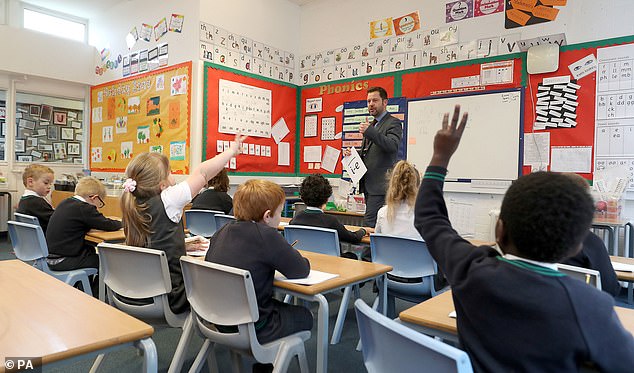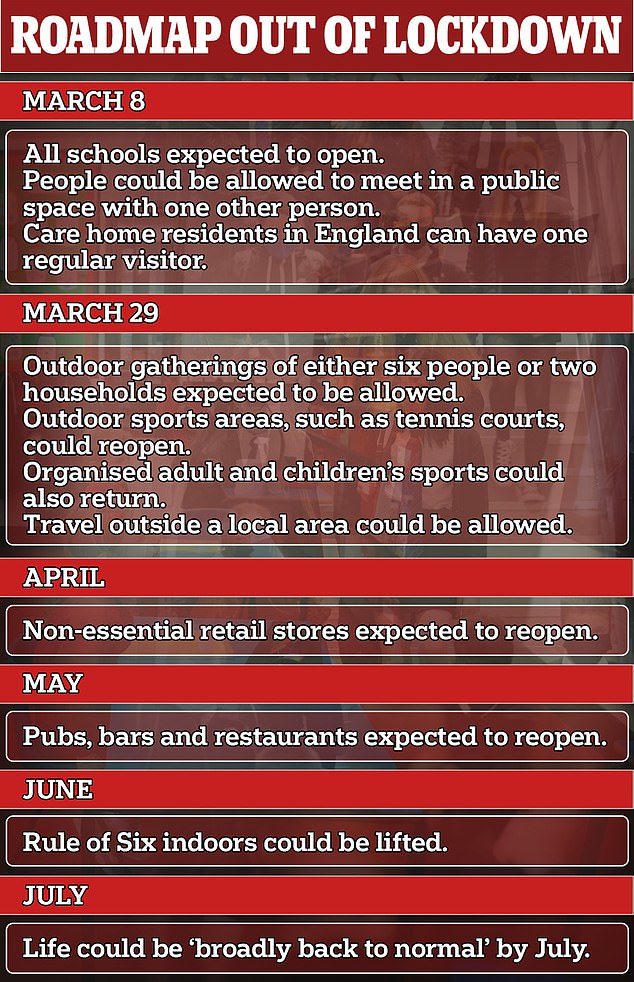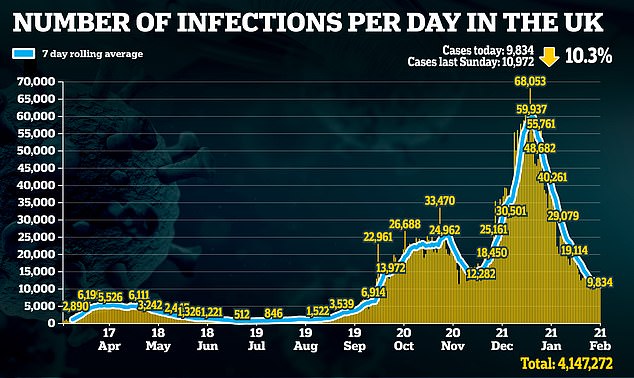Teachers were no more likely to catch the coronavirus than farm workers during England’s second wave, official data revealed today.
Education unions have joined forces to demand that Boris Johnson scrap his plan to reopen all schools in England on March 8 and are calling for a phased return instead.
Although there are fears coronavirus will spread out of control again when schools reopen, a report by the Office for National Statistics said there was ‘no evidence of a difference’ between infection rates among teachers and other jobs.
As well as farm workers and builders – classed as ‘elementary occupations’ – the risk was similar among other tradespeople, sales workers, health workers, drivers, secretaries and security guards.
The data add to growing evidence that schools appear not to be the hotbeds for transmission that they are for other viruses such as flu. Most have been closed for the majority of the past year, however, making comparisons difficult.
Nine teaching unions in England have banded together to urge Boris Johnson to drop his plans to have a big bang reopening of schools on March 8, and to phase the return instead, with primary schools first followed by older pupils.
Scotland and Wales will begin opening their schools to all children from tomorrow, while Northern Ireland and England will go back next month.
Meanwhile, the NASUWT teachers union today reiterated its call for teachers and other education staff to be given priority access to coronavirus vaccines. This has been turned down previously because teachers don’t face a higher than average risk of death.


Schools across England will reopen on March 8 under Boris Johnson’s lockdown exit strategy
ONS figures showed ‘teaching and education professionals’ had an average coronavirus infection rate of 4.39 per cent between September 1 and January 7.
But this risk may in fact be as low as 3.99 per cent, analysis showed, below the level for those in ‘elementary occupations’ – including farmers – who work outdoors.
Experts had claimed the similar infection rate among teaching staff compared to other professions was linked to school closures and online lessons previously.
But these figures suggest they are not at increased risk even while in the classroom.
NO EVIDENCE SCHOOLS TRIGGER LOCAL OUTBREAKS, STUDY FINDS
There is no evidence having schools open drives the spread of coronavirus in the wider community in the UK, SAGE advisers said last week.
In a study of pupil and teacher absences caused by positive Covid tests, researchers said confirmed infections in schools did not lead to bigger outbreaks.
Instead, they said there were small signs that the opposite was true, and that schools tended to get worse hit when the cases around them had rocketed.
Many pupils have been home-schooling for almost all of the past year, except for a brief period between September and December before the second wave spiralled out of control.
But education bosses fear rushing back to normal classes could lead to an explosion in cases, leading to more closures and greater disruption. Neither pupils nor staff will have been routinely vaccinated against the virus.
Dr Mike Tildesley and Dr Ed Hill, members of SAGE sub-group SPI-M and Warwick University experts who did the study published today, said the reopening should be cautious and that it was important to ‘mitigate’ the inevitable risks of doing it.
The team admitted their paper was ‘an absence of evidence rather than evidence of absence’ of risk. And they conceded it probably underestimated how many Covid cases there actually are in schools because many people don’t get tested.
The Warwick study found Covid cases among teachers fell during the November lockdown, even though schools remained open.
And in December, cases in schools appeared to rise in tandem with outbreaks in the community, with bigger outbreaks in London and the South East, where the new variant was surging, and fewer cases in more rural regions.
Evidence showed that the numbers of people taking time off appeared to track alongside general outbreaks in the area around the school.
But there was no sign cases in schools would predict an outbreak in the community. Instead, there was ‘weak’ evidence that the opposite was true, suggesting pupils and teachers were more likely to get infected elsewhere.
Secondary schools appeared to see more confirmed cases in pupils and teachers, the study found, compared to primaries.
Dr Tildesley said in a briefing: ‘We need to approach the data with an element of caution – this will be an underestimate of the true number of cases within schools.
‘There will be some children with very mild symptoms or no symptoms at all.’
Advertisement
The ONS study swab-tested more than 130,000 Britons for the virus from September to the beginning of this year and identified 5,156 positive cases.
This took place over the second national lockdown – from November 5 to December 1 – when teachers were still required to attend the classroom but work from home orders remained in place for all ‘non-essential’ workers, and also over Christmas.
Participants wrote down their professions before taking the test, and their results were then split to reveal the estimated risk of catching the virus by job type.
There were 25 professions in the report – including nurses, builders and security guards – which had an average positive test rate of 3.4 per cent.
Teachers had the fourth highest risk of becoming infected with the virus on average, the report said.
But analysis revealed their overall risk was not significantly different from 18 other professions on the list – that is, the differences between them were not large enough for random error to be ruled out.
The results for teachers were also broken down by type of educational establishment, which showed those in secondary education were most likely to test positive for the virus (5.42 per cent).
This was followed by primary school staff (5.21 per cent), senior professionals at education establishments (5.1 per cent) and special needs education staff (4.6 per cent).
The risk was lowest among higher education professionals such as university lecturers (2.48 per cent) and further education teachers (2.93 per cent).
Previous reports from the ONS have also suggested teachers are not at higher risk from the virus than those working in other professions.
The conclusion from the report for September 2 to October 16 said: ‘This analysis did not find statistical evidence of a difference in the positivity rate between primary and secondary school teachers, other key workers and other professions.’
Despite a lack of evidence that schools are high-risk, teaching unions are still demanding that Boris Johnson takes a more cautious approach to sending pupils back.
They want the Government to only proceed with any reopening on March 8 if the scientific evidence is ‘absolutely clear’ that it is safe to do so.
They also said that at that point ministers should ‘go no further than a phased return of children and young people’ to allow time to assess the impact on coronavirus infection rates of bringing back limited numbers of pupils.
The National Education Union said in its proposed recovery plan that the return to schools should see numbers allowed on-site limited while there should also be increased use of face coverings.
It said masks should be worn by secondary school pupils in classrooms as well as in all other areas of the school.
Union bosses are urging Mr Johnson to follow the example of Scotland and Wales where the phased return of some young children to classrooms started this morning.
There is growing speculation that teaching unions could strike if the premier refuses to back down.
But former head of Ofsted Sir Michael Wilshaw today demanded unions ‘do as much as is possible’ to get children back into classrooms as he warned of a ‘lost generation’.
Meanwhile, Sir Keir Starmer warned against industrial action as he said Labour would not support such a move.

Teaching unions warned the PM at the end of last week that it would be ‘reckless’ to send all children back to school at the same time amid warnings it could cause coronavirus infection rates to spike.
But the Government is set to push ahead with a full reopening, with Vaccines Minister Nadhim Zahawi telling ITV’s GMB programme: ‘March 8 is the date that we want to see all school children being back at school.’
Sir Michael said this morning that unions must work with the Government and teachers to ensure there is a smooth return to in-person learning.
He told GMB: ‘The Government has appointed what they are calling a catch-up tsar, someone called Kevin Collins, who… will be co-ordinating schools’ efforts and pointing to good practice.
‘I’m looking forward to the teacher unions really supporting this, and encouraging their members to do as much as is possible and to go the extra mile to support children.
‘It’s really important that this generation of youngsters is not seen as a lost generation – youngsters who feel that fate has given them a very, very bad hand, and they have suffered accordingly.
‘It’s important they get their confidence back and their self-esteem back and they look forward to the future with optimism.
‘That is why teachers and heads really need to pull together, and the unions as well supporting them, to make sure this generation is no longer seen as a lost generation.’
Sir Keir told LBC Radio this morning that Labour supports reopening all schools in England on March 8.
He said: ‘I want all of our schools ideally open on the 8th of March. That is what the Prime Minister has said and we want to see that ideally happen.’
Asked if he would support unions going on strike over the issue, he replied: ‘I don’t think there should be industrial action.
‘But I do think, the teaching unions are right to stick up for their members who have been through a really hard time in the last 12 months.
‘The stop start schooling, they have been obviously in schools for key workers and there has been a lot of stress and strain on school staff and they feel they haven’t been listened to by the Government.
‘I think Gavin Williamson should get on the phone to the unions and tell them what his plan is so everybody can get round the plan to get our children back to school as soon as possible.’
Union bosses said the Government’s ‘big bang’ approach to bringing back all children at the same time was ‘difficult to understand’.
Geoff Barton, general secretary of the Association of School and College Leaders (ASCL), said: ‘We share the Government’s aim of bringing all children back to the classroom as soon as possible, but we remain concerned about the idea of a ‘big bang’ approach of a full return of pupils all at the same time.

Mr Johnson’s plans for easing lockdown have been bolstered by the latest data whihc shows Covid-19 infection rates have continued to drop, with 9,834 more cases reported – a fall of 10 per cent on last week – while the 215 new daily deaths brought Britain’s total up to 120,580

‘This is very different from the plans in Scotland, Wales, and Northern Ireland in which a phased return is planned, and it is difficult to understand why the approach in England would go so much further.
Mr Barton added: ‘It is crucial that the return of all pupils to face-to-face education is safe and sustainable and that we don’t end up prolonging a cycle of disruption.’
Paul Whiteman, general secretary of the NAHT school leaders’ union, said Mr Johnson needed to make a ‘compelling case’ for his plan.
He said: ‘School leaders want nothing more than a safe return to school for all children but, crucially, that return has to be sustainable.
‘It is better to be cautious than to risk further closures and yet more disruption to children’s education. A third lockdown for schools would be more devastating than taking our time now.’
But Russell Viner, professor of adolescent health at UCL, said it is ‘plausible’ that schools in England can fully reopen on March 8 while keeping the pandemic under control – if the lockdown is maintained for other parts of society and the rapid vaccine rollout continues.
He said: ‘Reopening secondaries fully brings the greatest risk for increasing infections, but may bring the greatest benefits for the mental health and life chances of our children.
‘Schools should be the first part of society to reopen after lockdown. The risks of not reopening schools are high.’
Prof Viner added: ‘Schools undoubtedly play a role in transmission of this pandemic, particularly secondary schools. Yet the evidence suggests that transmission can be very much reduced when effective control measures are used in schools.’
The return of schools in Wales today will see children aged three to seven head back to classrooms. Some vocational college students are also going back.
The Welsh government is planning for the remaining primary school pupils as well as those in years 11 and 13 facing exam years to return from March 15 in a ‘flexible way’.
A similar approach is being taken in Scotland, with children in primaries one to three due back in Scottish schools from today along with some senior secondary pupils who need to do practical work for qualifications.
All children under school age in early learning and childcare are also returning.
Source link : https://www.dailymail.co.uk/news/article-9285947/All-schools-England-reopen-March-8.html











